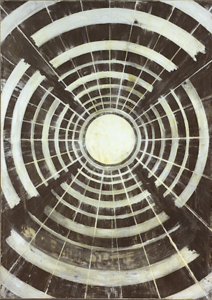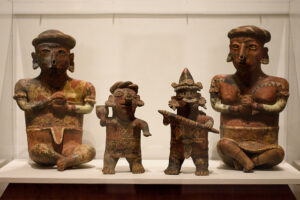Today’s post comes from Pilar Jefferson, class of 2015 and Art Center Student Docent.

Male Fish Gut, 2006
Ink, pencil, and crayon
30 x 44 inches
Collection of Edward J. Guarino
Reproduced with the permissions of Dorset Fine Arts
Male Fish Gut—probably the last title you’d expect for a beautiful work of art. And yet there I was, standing in the Focus Gallery, one of the Art Center’s temporary exhibition spaces, completely entranced by what is for all intents and purposes a representation of what’s inside a dead fish. Male Fish Gut is a drawing by Inuit artist Siassie Kenneally, who achieves the daunting task of making something that might be repulsive, suddenly engaging. But first, some background about why Kenneally’s work is currently gracing the walls of the Art Center.
Until very recently I don’t think I’d ever encountered Inuit art. In fact, I knew very little about the Inuit in general which, for those who are in the same boat I was in, is the proper name for the Indigenous people of the Canadian Arctic. I was, however, interested in the relationship between Indigenous people and art museums which is why I decided to take the course Decolonizing the Exhibition: Critical Approaches to Contemporary Indigenous Art, taught by Vassar professor of English and Native American Studies, Molly McGlennen. Kenneally is one of many artists represented in the fifteen Inuit works on paper that are part of a gallery/online exhibition that is the culmination of the course. Male Fish Gut was on view in the gallery in October and November and is now part of the online exhibition of all fifteen works (http://pages.vassar.edu/amst282); eight works are up in the gallery now through February 2, 2014. All of the works have interpretive labels written by myself and my peers, to give museum-goers deeper insight into Inuit art.
Male Fish Gut is a perfect example of what makes Inuit works on paper compelling. Kenneally uses line and color to draw out the subtleties of shade and form that make this peculiar subject beautiful. The work is done in crayon, ballpoint pen and colored pencil, materials not normally associated with fine art. However, in combination the three media work in harmony to deepen the viewer’s engagement. The artist used pen to outline the various organs, some of which are transparent and overlap one another revealing the interconnectedness of the animal’s internal system. All of the organs are then shaded with colored pencil and crayon, the former highlighting the direction of the sinew of the fish and the latter emphasizing its three-dimensionality. Pencil and crayon combine to create layers of color, from deep pink to shades of black and purple, mimicking the complex tones that are found in real flesh.
This drawing is only one of many exciting works on paper in Decolonizing the Exhibition. Kenneally’s work can be seen as an analogy for the exhibition as a whole, which works to affirm Inuit culture as unique, beautiful, and very much alive. Through the exhibition Inuit art and culture are made tangible, emphasizing the fact that Inuit people are living in the same world as the rest of us and dispelling the myth that indigeneity is only related to the past. Male Fish Gut represents the ways in which art can create new perspectives; materials are given new life, subject matter is seen in a new light, and cultures at a distance are brought newly into focus.




